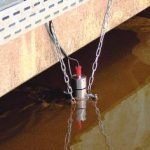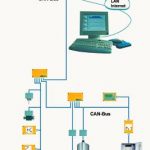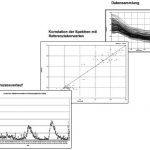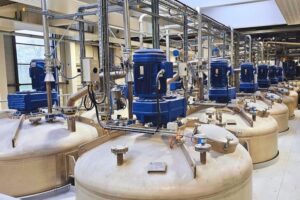Spectroscopic measurements taken directly in the process tanks at a waste water treatment plant give an immediate analysis for control parameters such as nitrate, COD and BOD from a single measuring probe. Modern probes can transmit a complete sample spectrum to an analyser, which uses stored calibrations and a multi-variable statistical calculation to quantify the value of each parameter.
Dr. Olaf Kranz
Measurements with in-situ photometric probes are well established in the water industry due to the advantages they offer – no sample preparation, practically real-time analysis and direct measurement. One complete spectrum holds enough information to calculate the results for several parameters using previously stored calibrations. No chemicals are needed, and the robust sensors are easy to use. Taking the measurement directly at the sampling point eliminates errors from non-representative sampling, transport, storage and dilution.
Most waste water treatment plants present a challenging sample matrix, with many different possible components and a correspondingly wide variety of spectral properties. Similarly, the plant operating conditions can also have a large influence on the quality of the measured spectra. This means that it is frequently impossible to rely on measurements taken at a single wavelength followed by a simple calculation based on the Lambert-Beer law, as in classical UV/vis spectroscopy, to produce an accurate analysis. In a typical waste water sample, broad absorbance bands and overlapping wavelength ranges make it difficult to depend on such a simple measurement. Furthermore, in nearly every case non-linear relationships and interferences occur as a result of the interactions between dissolved and non-dissolved components, which can vary according to the precise process conditions. In particular, where a large amount of solids are present, variations in the flow rate and conditions inside the tank result in light scattering which affects readings throughout the whole spectrum.
Using chemometric techniques it is pos-sible to establish a relationship between measured spectra and wavelength-specific parameters such as nitrate, and also – within limits – with non-specific sum parameters such as COD and BOD.
Immersion probe
The totally submerged Isis probe is constructed from stainless steel and equipped with a UV-halogen light source, a 256-pixel diode array detector and control electronics. According to type, a wavelength range of 200 to 380 nm or 200 to 750 nm is scanned. A single scan takes about five seconds, and the probe is purged between sample measurements with a flow of compressed air. Variable path lengths are available, in a range from either 1 to 10 mm or 10 to 60 mm; the path length can be adjusted to suit the particular type of sample and measurement.
The measured spectra are transmitted to a modular analysis and control system, the Blue Box, where the analytical results are calculated using previously stored calibrations. The spectra and the parameters are continuously stored and can be transmitted to a control computer by LAN, radio, GSM, text message, email or internet.
Developing calibrations
A calibration is established by correlating spectral data collected by the sample probe with values from a reference analysis. The basis for the calibration is two sets of data – the measured absorbance values at each wavelength and the results of the reference analysis.
The reference analysis should be a direct, accurate procedure whose statistical values such as reproducibility and accuracy are known. Any errors in the reference values will be reflected in the calibration. When collecting data for the calibration, representative sample spectra are needed which are distributed as evenly as possible over the expected measuring range. Normally at least 30 calibration points are needed for each parameter, and it is particularly important that values at the limits of the calibration range are included.
The calibration is calculated and evaluated using statistical procedures that include the important Standard Error of Estimation, which gives a quantitative measure of the correlation between the reference values and the calculated values. Ideally this should be of the same order of magnitude as the error in the reference method. The Multiple Correlation Coefficient should be as close as possible to 1. In practice this optimum value is never achieved, and a correlation coefficient higher than 0.75 is generally accepted as suitable to provide a usable calibration.
The calibration is then validated using spectral data from samples which were not included in the calibration. These measurements produce a value for the error of prediction (RMSEP, Root Mean Square Error of Prediction), which is one of the most useful ways of evaluating a calibration model.
To establish a robust calibration, samples should be included which cover all the possible variations of in-process and operating conditions. Factors known to influence the calibration include variations in the composition of the waste water, turbidity changes due to changes in the suspended solids load and the dispersion effects due to variations in flow rates and dispersion patterns.
Results and conclusions
For the most commonly measured parameter Nitrate (NO3-N) a calibration in a typical waste water treatment plant can achieve a correlation coefficient of up to 0.93 and an error of prediction between 0.3 and 0.5 mg/l. The variations in the process conditions measured by the sample probe have then been shown to be representative of those obtained with reference measurements carried out in parallel. A general calibration can be improved in terms of accuracy, reproducibility and long-term stability (robustness) by adding local measurements to the basic data set. Process-relevant sum parameters such as COD and BOD typically show inferior correlations due to the presence of particular substances which are wavelength-dependant. Up to now these local calibrations have had only a limited range of sample spectra; furthermore, the reference analysis for these parameters shows a much higher degree of uncertainty. These calibrations can undoubtedly be improved by incorporating further data. As such, the Isis immersion probe from Bran+Luebbe offers a very interesting alternative to previous methods of process analysis.
cpp 461
More about Isis
Seminars for Maintenance and Operating Personnel 2005
Share:









